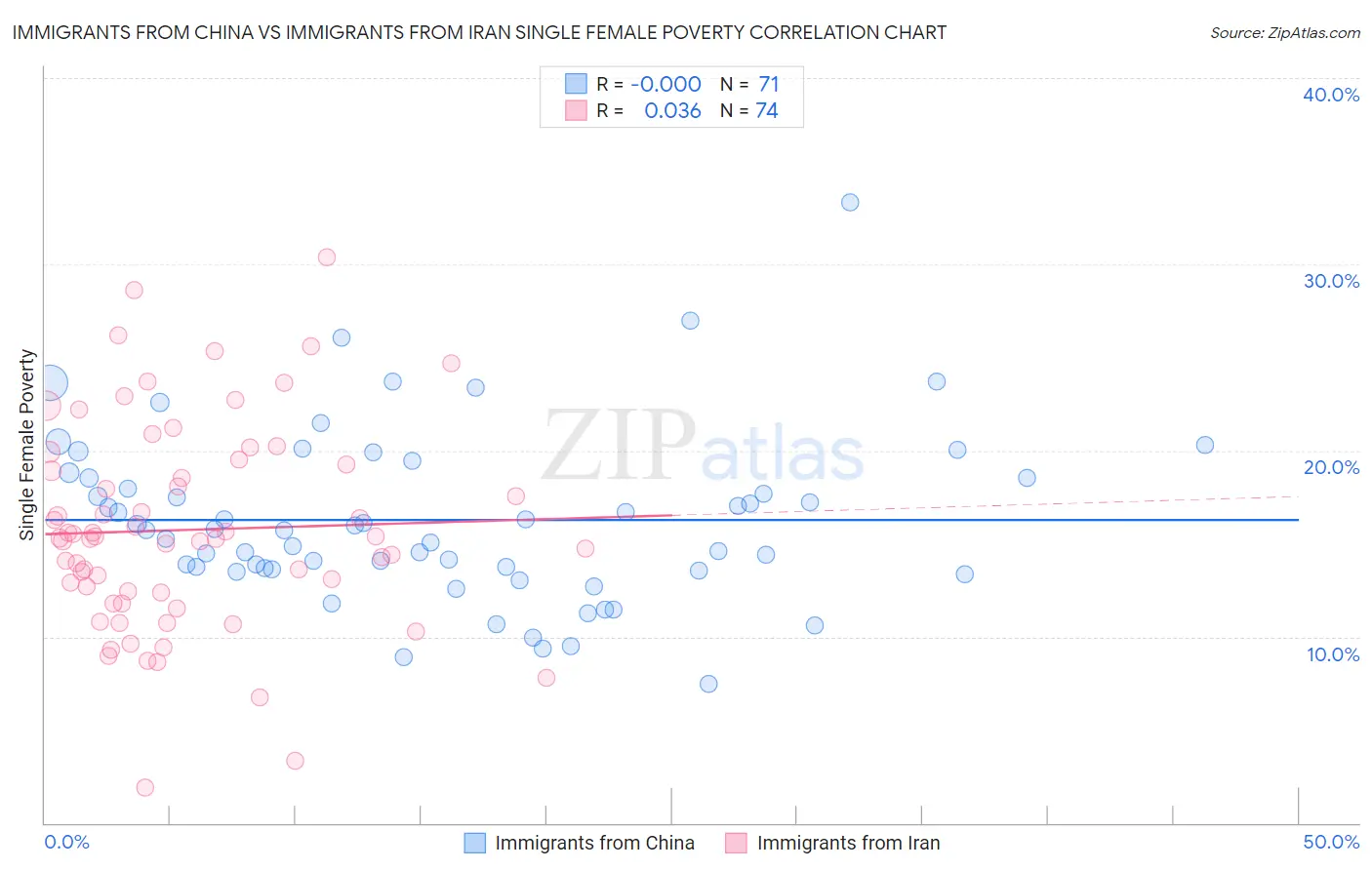Immigrants from China vs Immigrants from Iran Single Female Poverty
COMPARE
Immigrants from China
Immigrants from Iran
Single Female Poverty
Single Female Poverty Comparison
Immigrants from China
Immigrants from Iran
18.1%
SINGLE FEMALE POVERTY
100.0/ 100
METRIC RATING
19th/ 347
METRIC RANK
17.5%
SINGLE FEMALE POVERTY
100.0/ 100
METRIC RATING
8th/ 347
METRIC RANK
Immigrants from China vs Immigrants from Iran Single Female Poverty Correlation Chart
The statistical analysis conducted on geographies consisting of 446,922,860 people shows no correlation between the proportion of Immigrants from China and poverty level among single females in the United States with a correlation coefficient (R) of -0.000 and weighted average of 18.1%. Similarly, the statistical analysis conducted on geographies consisting of 276,267,918 people shows no correlation between the proportion of Immigrants from Iran and poverty level among single females in the United States with a correlation coefficient (R) of 0.036 and weighted average of 17.5%, a difference of 4.0%.

Single Female Poverty Correlation Summary
| Measurement | Immigrants from China | Immigrants from Iran |
| Minimum | 7.4% | 1.9% |
| Maximum | 33.3% | 30.4% |
| Range | 25.9% | 28.5% |
| Mean | 16.3% | 15.7% |
| Median | 15.7% | 15.3% |
| Interquartile 25% (IQ1) | 13.6% | 12.3% |
| Interquartile 75% (IQ3) | 18.6% | 19.3% |
| Interquartile Range (IQR) | 4.9% | 6.9% |
| Standard Deviation (Sample) | 4.6% | 5.6% |
| Standard Deviation (Population) | 4.5% | 5.5% |
Demographics Similar to Immigrants from China and Immigrants from Iran by Single Female Poverty
In terms of single female poverty, the demographic groups most similar to Immigrants from China are Immigrants from Eastern Asia (18.1%, a difference of 0.030%), Immigrants from Korea (18.1%, a difference of 0.32%), Immigrants from Greece (18.3%, a difference of 0.68%), Maltese (18.3%, a difference of 0.74%), and Burmese (18.3%, a difference of 0.75%). Similarly, the demographic groups most similar to Immigrants from Iran are Thai (17.3%, a difference of 0.99%), Bhutanese (17.7%, a difference of 1.4%), Immigrants from Ireland (17.8%, a difference of 1.8%), Immigrants from Lithuania (17.8%, a difference of 1.9%), and Immigrants from South Central Asia (17.8%, a difference of 2.0%).
| Demographics | Rating | Rank | Single Female Poverty |
| Immigrants | Hong Kong | 100.0 /100 | #3 | Exceptional 16.5% |
| Immigrants | India | 100.0 /100 | #4 | Exceptional 16.8% |
| Assyrians/Chaldeans/Syriacs | 100.0 /100 | #5 | Exceptional 17.0% |
| Filipinos | 100.0 /100 | #6 | Exceptional 17.0% |
| Thais | 100.0 /100 | #7 | Exceptional 17.3% |
| Immigrants | Iran | 100.0 /100 | #8 | Exceptional 17.5% |
| Bhutanese | 100.0 /100 | #9 | Exceptional 17.7% |
| Immigrants | Ireland | 100.0 /100 | #10 | Exceptional 17.8% |
| Immigrants | Lithuania | 100.0 /100 | #11 | Exceptional 17.8% |
| Immigrants | South Central Asia | 100.0 /100 | #12 | Exceptional 17.8% |
| Immigrants | Bolivia | 100.0 /100 | #13 | Exceptional 17.8% |
| Bolivians | 100.0 /100 | #14 | Exceptional 17.9% |
| Indians (Asian) | 100.0 /100 | #15 | Exceptional 17.9% |
| Iranians | 100.0 /100 | #16 | Exceptional 18.0% |
| Immigrants | Korea | 100.0 /100 | #17 | Exceptional 18.1% |
| Immigrants | Eastern Asia | 100.0 /100 | #18 | Exceptional 18.1% |
| Immigrants | China | 100.0 /100 | #19 | Exceptional 18.1% |
| Immigrants | Greece | 100.0 /100 | #20 | Exceptional 18.3% |
| Maltese | 100.0 /100 | #21 | Exceptional 18.3% |
| Burmese | 100.0 /100 | #22 | Exceptional 18.3% |
| Asians | 100.0 /100 | #23 | Exceptional 18.3% |